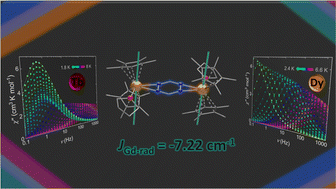New members of radical bridged Ln2 metallocene single-molecule magnets based on the unsubstituted 1,2,4,5-tetrazine ligand†
Abstract
Magnetic coupling plays a critical role in the overall magnetic behaviour of a single-molecule magnet (SMM). Through a careful design strategy that employs the highly delocalized 1,2,4,5-tetrazinyl (tz) radical anion with lanthanide metallocenes, a new family of dinuclear complexes was isolated; [(Cp*2LnIII)2(tz˙−)(THF)2](BPh4), (Ln = Gd (1), Tb (2), Dy (3); THF = tetrahydrofuran; Cp* = pentamethylcyclopentadienyl). The strong magnetic exchange coupling of JGd–rad = −7.2 cm−1 observed in 1, was probed through SQUID magnetometry as well as computational studies. This, combined with the highly anisotropic TbIII and DyIII ions in 2 and 3, respectively, leads to zero-field SMM behaviour and slow relaxation of the magnetization through thermally activated processes. These dinuclear complexes serve as ideal models for understanding the magnetic interactions between 4f elements.



 Please wait while we load your content...
Please wait while we load your content...